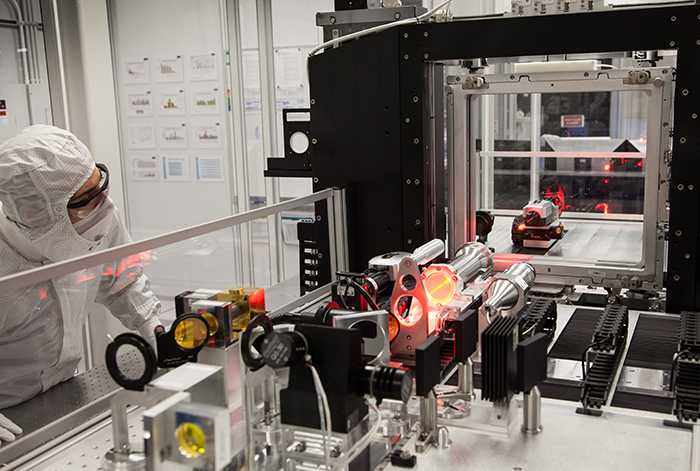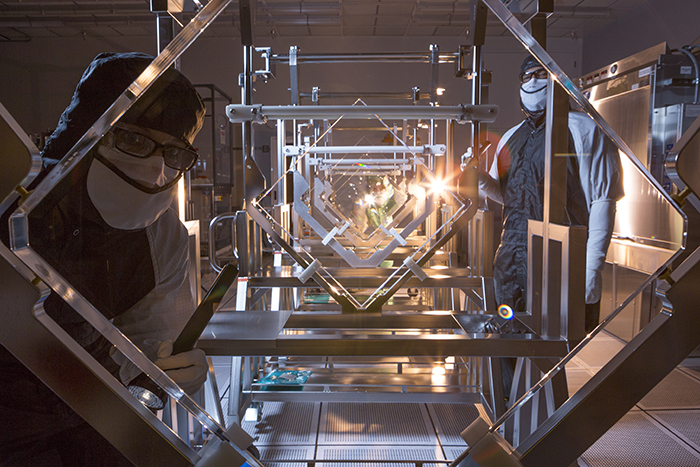Repairing NIF Optics Damage Shows LLNL’s Advanced Manufacturing Potential
April 12, 2019
The following is an edited excerpt from an article by Allan Chen in the March 2019 issue of Science & Technology Review:
 Optics Mitigation Facility operator Constantine Karkazis inspects the facility’s CO2 laser processing hardware. Credit: Bruno Van Wonterghem
Optics Mitigation Facility operator Constantine Karkazis inspects the facility’s CO2 laser processing hardware. Credit: Bruno Van Wonterghem NIF’s laser optics damage mitigation program is one example of how the private sector is benefiting from Lawrence Livermore National Laboratory’s Advanced Manufacturing Laboratory (AML).
AML is a 1,300-square-meter facility where Livermore scientists and engineers are working side by side with partners in the private sector and academia to create new materials and technologies. AML is currently home to more than half a dozen partnerships, and more are in the pipeline.
One partnership involves NIF, where large fluxes of energy pass through the optics of the 192 beams comprising the world’s highest energy laser. With repeated shots, tiny pits in NIF’s optical glass can enlarge to become damage sites that compromise performance.
“The Laboratory has made a substantial effort to mitigate damage precursors and initiated damage sites on NIF’s large optics,” says Ibo Matthews, a group leader in Livermore’s Materials Science Division. “The damage mitigation process we developed uses carbon dioxide lasers to repair damage on the surfaces of silica optics, smoothing their imperfections. We realized that this process could be used for the laser polishing of glass, even the localized repair of NIF optics.”
 Schematic showing the NIF laser damage repair process, which uses a scanned, pulsed, and focused CO2 laser spot to evaporate a conical pit: (Left) cross-section view and (Right) angle view from top.
Schematic showing the NIF laser damage repair process, which uses a scanned, pulsed, and focused CO2 laser spot to evaporate a conical pit: (Left) cross-section view and (Right) angle view from top. The enabling research was funded primarily by the Laboratory Directed Research and Development Program.
At a conference in 2014, a presentation about the technology by Matthews, Materials Science Division staff scientist Nan Shen, and their team attracted the attention of Edmund Optics, which quickly entered into talks with Livermore.
The U.S.-based company eventually established a Cooperative Research and Development Agreement (CRADA) to work with the Lab at AML. The partnership’s goal is to extend Livermore’s technology into a commercial system capable of polishing industrial lenses and mirrors to the same high surface quality demanded by NIF.
 NIF researchers have developed a method to mitigate optics laser damage using laser ablation.
NIF researchers have developed a method to mitigate optics laser damage using laser ablation. Advanced technology is reshaping and transforming manufacturing the world over. Signs of this transformation are everywhere: factory automation, machine learning, additive manufacturing, robotics, and cloud-based process management, to name only a few trends.
Livermore contributes to this renaissance through its research and development (R&D) in fields such as advanced manufacturing, industry partnerships that use the Laboratory’s high-performance computing to improve industrial processes, and commercializing new manufacturing technologies.
R&D at the AML aims to further Livermore’s national security missions while enabling partners to release new products and services into the marketplace, a process called spin-in/spin-out technology development.
AML’s facilities reflect Livermore’s process expertise across a broad spectrum of materials and scales, including direct ink writing, powder bed fusion, electrophoretic deposition, projection microstereolithography, and laser-based processes such as two-photon lithography and selective laser melting.
With these capabilities, partners on the applications track can develop new materials and components for nearly any sector — transportation, defense, energy, or biomedicine, for example. With some advanced manufacturing processes promising shorter development times, the qualification and certification track is tailored to accelerate the commercial acceptance of new materials, processes, and components.
For more information, go to str.lln.gov.
Follow us on Twitter: @lasers_llnl



